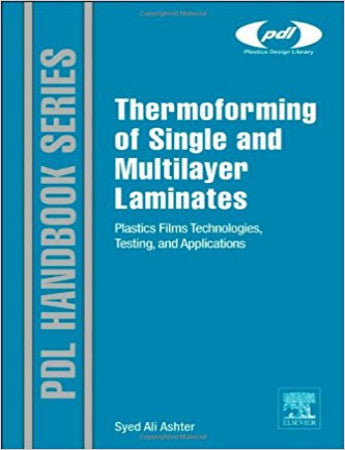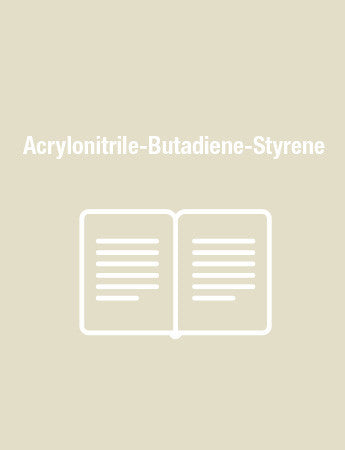Thermoforming of Single and Multilayer Laminates, 1st Edition
Key Features
• First comprehensive source of information and hands-on guide for the thermoforming of multilayered laminates
• Covers applications across such sectors as automotive, packaging, home goods, and construction
• Introduces new testing methods leveraging protocols used for metals
Description
Thermoforming of Single and Multilayer Laminates explains the fundamentals of lamination and plastics thermoforming technologies along with current and new developments. It focuses on properties and thermoforming mechanics of plastic films and in particular single and multilayered laminates, including barrier films.
For environmental and economic reasons, laminates are becoming increasingly important as a replacement for solid sheets and paint finishes in many industries, including transportation, packaging, and construction. Yet the processes of film formability during the extensive deformation and elevated temperatures experienced in conventional processing technologies, such as thermoforming, are poorly understood by most engineers.
This book covers production processes, such as extrusion, calendaring, and casting, as well as mechanical and impact testing methods. It also describes how testing protocols developed for metals can be leveraged for plastic films and laminates and includes a thorough discussion on methods for performing optical strain analysis.
Applications in transportation vehicles and packaging, including packaging for food, medical and electronics applications, sports equipment, and household appliances, are discussed. Safety, recycling and environmental aspects of thermoforming and its products complete the book.
Readership
Engineers working with plastics films or products using plastic films (OEM level to the actual part manufacturer of thermoforming) in industries such as Automotive/ transportation manufacturing, Packaging, Plastics Industry, Paint Industry; Personnel involved in testing and QA of products using plastics films, and managers; Academic Institutions
• First comprehensive source of information and hands-on guide for the thermoforming of multilayered laminates
• Covers applications across such sectors as automotive, packaging, home goods, and construction
• Introduces new testing methods leveraging protocols used for metals
Description
Thermoforming of Single and Multilayer Laminates explains the fundamentals of lamination and plastics thermoforming technologies along with current and new developments. It focuses on properties and thermoforming mechanics of plastic films and in particular single and multilayered laminates, including barrier films.
For environmental and economic reasons, laminates are becoming increasingly important as a replacement for solid sheets and paint finishes in many industries, including transportation, packaging, and construction. Yet the processes of film formability during the extensive deformation and elevated temperatures experienced in conventional processing technologies, such as thermoforming, are poorly understood by most engineers.
This book covers production processes, such as extrusion, calendaring, and casting, as well as mechanical and impact testing methods. It also describes how testing protocols developed for metals can be leveraged for plastic films and laminates and includes a thorough discussion on methods for performing optical strain analysis.
Applications in transportation vehicles and packaging, including packaging for food, medical and electronics applications, sports equipment, and household appliances, are discussed. Safety, recycling and environmental aspects of thermoforming and its products complete the book.
Readership
Engineers working with plastics films or products using plastic films (OEM level to the actual part manufacturer of thermoforming) in industries such as Automotive/ transportation manufacturing, Packaging, Plastics Industry, Paint Industry; Personnel involved in testing and QA of products using plastics films, and managers; Academic Institutions
Preface
Acknowledgments
1. Introduction to Thermoforming
1.1 History
1.2 Market and Applications
References
2. The Thermoforming Process
2.1 Background
2.2 Basic Principles of Thermoforming
2.3 Difference between Plastic Sheets and Laminates
2.4 Theory of Forming Process
2.5 Forming Characteristics
2.6 Machinery
References
3. Review of Characteristics of Common Plastics for Thermoforming
3.1 Impact of Main Variables
References
4. Lamination
4.1 Why Laminates?
4.2 Elements of Laminates
4.3 Typical Commercial Laminates
4.4 Hot-Roll Lamination
4.5 Extrusion Lamination
4.6 Flame Lamination
4.7 Adhesive Lamination
References
5. New Developments
5.1 Heating Technology
5.2 Trimming Technology
5.3 Thickness Reduction
5.4 Pressure Forming
5.5 Vacuum Forming
5.6 Twin-Sheet Forming
5.7 Reinforced-Sheet Forming
5.8 Multilayer Sheet Forming
5.9 Biaxial Bulge
5.10 Biaxial Strain
5.11 Bulge Test Models
References
6. Mechanics of Materials
6.1 Stress
6.2 Strain
6.3 Stress Relaxation and Creep
6.4 Creep and Stress Relaxation Models
6.5 Peeling
6.6 Delamination
References
7. Characterization
7.1 Mechanical Testing
7.2 Impact Testing
7.3 Biaxial Bulge Testing
7.4 Rheological Testing
7.5 Differential Scanning Calorimetry (DSC)
7.6 Color Test
7.7 Specular Gloss Test
References
8. Matching Material Characteristics to Commercial Thermoforming
8.1 Packaging
8.2 Appliances
8.3 Bathroom
8.4 Transportation
8.5 Sports
References
9. Safety, Recycling and Environmental Issues of Thermoforming and its Products
9.1 Safety
9.2 Safety Guards
9.3 Recycling
9.4 The Economics of Recycling
9.5 Handling of Scrap
9.6 Contamination
9.7 Environmental Impact
References
10. Other Processing Approaches
10.1 Melt Extrusion
10.2 Coextrusion
10.3 Calendering
10.4 Casting
10.5 Coating
References
11. Modeling of Thermoforming: A Literature Review
11.1 Models
References
12. Troubleshooting
12.1 Thermoforming
12.2 Hot-Roll Lamination
References
Index
Acknowledgments
1. Introduction to Thermoforming
1.1 History
1.2 Market and Applications
References
2. The Thermoforming Process
2.1 Background
2.2 Basic Principles of Thermoforming
2.3 Difference between Plastic Sheets and Laminates
2.4 Theory of Forming Process
2.5 Forming Characteristics
2.6 Machinery
References
3. Review of Characteristics of Common Plastics for Thermoforming
3.1 Impact of Main Variables
References
4. Lamination
4.1 Why Laminates?
4.2 Elements of Laminates
4.3 Typical Commercial Laminates
4.4 Hot-Roll Lamination
4.5 Extrusion Lamination
4.6 Flame Lamination
4.7 Adhesive Lamination
References
5. New Developments
5.1 Heating Technology
5.2 Trimming Technology
5.3 Thickness Reduction
5.4 Pressure Forming
5.5 Vacuum Forming
5.6 Twin-Sheet Forming
5.7 Reinforced-Sheet Forming
5.8 Multilayer Sheet Forming
5.9 Biaxial Bulge
5.10 Biaxial Strain
5.11 Bulge Test Models
References
6. Mechanics of Materials
6.1 Stress
6.2 Strain
6.3 Stress Relaxation and Creep
6.4 Creep and Stress Relaxation Models
6.5 Peeling
6.6 Delamination
References
7. Characterization
7.1 Mechanical Testing
7.2 Impact Testing
7.3 Biaxial Bulge Testing
7.4 Rheological Testing
7.5 Differential Scanning Calorimetry (DSC)
7.6 Color Test
7.7 Specular Gloss Test
References
8. Matching Material Characteristics to Commercial Thermoforming
8.1 Packaging
8.2 Appliances
8.3 Bathroom
8.4 Transportation
8.5 Sports
References
9. Safety, Recycling and Environmental Issues of Thermoforming and its Products
9.1 Safety
9.2 Safety Guards
9.3 Recycling
9.4 The Economics of Recycling
9.5 Handling of Scrap
9.6 Contamination
9.7 Environmental Impact
References
10. Other Processing Approaches
10.1 Melt Extrusion
10.2 Coextrusion
10.3 Calendering
10.4 Casting
10.5 Coating
References
11. Modeling of Thermoforming: A Literature Review
11.1 Models
References
12. Troubleshooting
12.1 Thermoforming
12.2 Hot-Roll Lamination
References
Index




